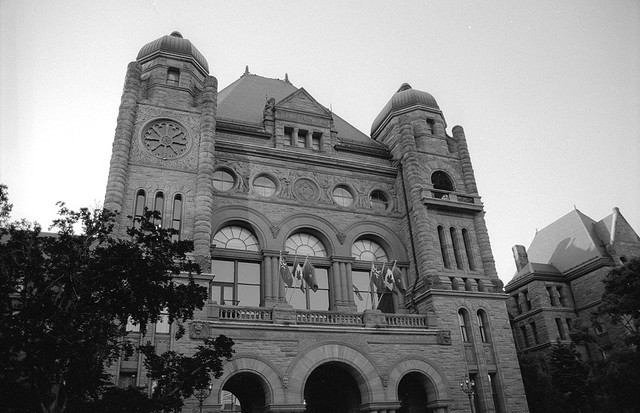If you just read the words, and didn’t look at the numbers, Ontario’s 2015 budget is a magical integration of the government’s high-profile infrastructure and pension initiatives with the need to maintain the public services that Ontarians count on.
The budget devotes page after page to trumpeting the government’s commitments to elementary and secondary education, post-secondary education, child care, health and poverty reduction at the same time as it highlights investments in infrastructure and the continued development of the Ontario Registered Pension Plan (ORPP). The budget even mentions homelessness as an issue that concerns the government.
Unfortunately, the story looks very different when you look at the numbers. When you look at the numbers, it is clear that everything else — every other service that Ontarians depend on — has been thrown under the infrastructure bus.
Elementary and secondary education spending is going up at less than the rate of inflation, and that includes the remaining cost of implementing full-day kindergarten. Postsecondary education will actually be dropping at a rate of 0.4 per cent per year on the way to budget balance. Health care is to increase at less than the rate of inflation.
The budget makes reference to its poverty reduction strategy. But the only concrete measure is social assistance benefits are being increased — by 1 per cent, less than the rate of inflation. The numbers say that social assistance benefits — both Ontario Works and ODSP — are still lower by 5-7 per cent, after accounting for inflation, than they were at the end of the Harris era.
On the way to budget balance, expenditures on children and social services will increase by less than one third of the rate of inflation.
There’s not much that is new on the infrastructure front. The numbers won’t be changing that much. Total infrastructure investment increased from $13.3 billion to $13.5 billion between 2014-15 and 2015-16. But the priority has clearly shifted. None of the transit money listed as in the pipeline is destined for the City of Toronto. It is now clear that Toronto has spent all of its transit infrastructure expansion money on the Scarborough subway.
Taking a step back from the detail, some critical gaps are clearly evident. You’d never know from reading this budget that there is a growing consensus that Ontario’s fiscal problems are on the revenue side, not the expenditure side. There’s nothing in the budget to address either the current revenue gap, or the prospect of federal health funding cuts that will make that gap even wider. Tax continues to be a four-letter word, as far as the government is concerned. You’d never know from reading this budget that Ontario’s investment in child care lags far behind that of Quebec. You’d never know from reading this budget that Ontario’s investment in elementary and secondary education on a per-student basis lags behind that of competitor jurisdictions in the United States. You’d never know from reading this budget that Ontario’s investment per student in post-secondary education is the lowest in Canada.
The sheer volume of words aside, there are four clear messages in this year’s budget:
- The overriding priority is to balance the budget by 2017-18, regardless of what happens between now and then;
- There will be no substantial action to address the revenue side of the government’s finances despite widespread agreement that it is revenue that is the key fiscal problem the government faces;
- Infrastructure aside, every other public services gap in Ontario is being shoved to the sidelines; and
- The thousands of Ontarians who serve the province in the public sector are expected to bear the largest share of the burden imposed by the government’s commitment to meeting its budget balance target.
It is encouraging that the government is continuing to move forward with the ORPP and is clearly rethinking many of the limitations on the plan implied by its initial discussion paper. This investment in the long-term retirement income security of generations of Ontarians who are not yet elderly themselves is a critical priority.
What is most disappointing, however, is the failure of the government to make use of its majority mandate to make some of the key difficult decisions that would put Ontario’s public services and its public finances on a more secure footing for the future.
Hugh Mackenzie is a CCPA research associate. Follow him on Twitter @MackHugh.
Photo: Jason Spaceman/flickr




